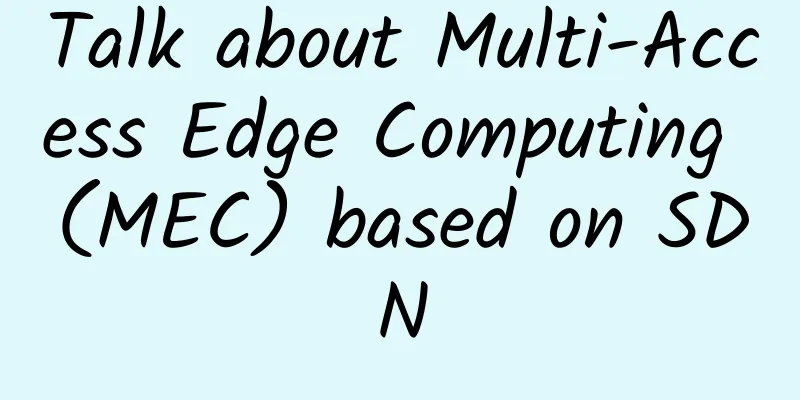Talk about Multi-Access Edge Computing (MEC) based on SDN

|
The development of data generation and data processing has a strong impact on the demand and evolution of the underlying infrastructure network. 5G networks are often seen as the harbinger of ubiquitous high-speed connectivity that can meet data demands. That being said, 5G networks still face many significant challenges in fulfilling this promise.
ETSI has proposed Multi-Access Edge Computing (MEC) to address some of these challenges. This article discusses these challenges and how to add network programmability to MEC to improve the overall MEC solution. challenge To support the growth of IoT devices, 5G wireless infrastructure will need to support a large number of connected devices and complex applications. This will require the network to support high scalability, ultra-low latency, high throughput, and reliable data transmission. These critical latency and bandwidth requirements prompted ETSI to propose multi-access edge computing as a viable solution to push services to the edge and closer to end users. But this approach also brings a series of challenges:
Proposed Solution One possible solution to address some of the above challenges is to introduce a MEC coordinator into the system. This MEC coordinator is aware of the available MEC servers and their capabilities (in terms of the resources and services they provide). In other words, the MEC coordinator acts as a proxy of sorts that connects applications to the right MEC servers. The MEC coordinator isolates the operator from network decisions such as:
The MEC coordinator can make these decisions based on various factors such as server capabilities, current load, and its location. Furthermore, the MEC coordinator can leverage SDN concepts for service discovery (to track instances of services) and orchestration (service instantiation and management) needs of MEC services. The centralized SDN controller has a global view of the network. The MEC coordinator can be integrated with the SDN controller to collect information from the network. The MEC coordinator can internally maintain a database of services available on MEC servers. It can use the SDN controller to connect the right MEC server to the application request. For example, an end user can request a facial recognition service just by mentioning the name of the service. The MEC coordinator will identify the MEC server that provides this service and add flows in the network accordingly. Solving latency issues The two main motivations behind the concept of MEC systems are computation offloading and latency reduction. The latency of centralized data centers or public clouds is very high. This is why MEC servers are deployed so close to the edge. Before deciding where to process a request, the MEC coordinator must make an intelligent decision based on the latency, energy, and bandwidth requirements of the client request. There are two main considerations that must be taken into account when trying to reduce latency:
The MEC coordinator needs to come up with a solution that minimizes the energy consumption of the devices and meets the execution latency constraints (latency requirements) of the client requests or applications. In addition, the nature of the application needs to be considered - whether it is latency sensitive (high responsiveness requirements) or compute intensive. Latency sensitive requests should be moved to MEC servers close to the client (even if they have fewer resources), while compute intensive requests will target more powerful MEC servers (even if they are farther away from the client device). Therefore, different network slices from the same device may have different paths and may be handled by different MEC servers. Integration of SDN controller and MEC The first version of the MEC ETSI specification seems to be inclined towards providing MEC services as "network services" on a virtualized platform. These services are basically a combination of VNFs running software related to network middlebox functions. By building the solution on an NFV platform, the complete lifecycle of these MEC services (instantiation, termination, expansion, etc.) can be managed. The NFV platform also supports VNF forwarding graphs to implement service chains of VNFs on MEC services. Adding SDN to the platform can make the network more flexible and dynamic. SDN allows a global view of the underlying network, so traffic steering rules can be applied to implement complex service chaining scenarios. It can be used to manage the network of interconnected distributed MEC servers. The SDN controller can host a “MEC coordinator northbound application” which can be programmed to handle various scenarios:
Therefore, the MEC coordinator can reuse the SDN architecture, where customized northbound applications define the behavior of the network. The SDN controller provides northbound APIs for these applications to trigger commands. The controller also has a southbound interface (usually based on OpenFlow), which communicates with the managed devices (using OpenFlow switches in the network). Commands from northbound applications in the MEC coordinator can be converted by the SDN controller into low-layer traffic control rules based on OpenFlow and sent to OpenFlow devices connected to or as part of the MEC server in the network. These OpenFlow rules can be integrated with the rules of the "traffic offload service" running on the MEC server. The "traffic offload service" is a MEC platform service responsible for routing traffic to the MEC application or MEC applications. ***, Status and statistics from OpenFlow devices can be communicated back to the MEC coordinator application by the SDN controller. This provides the MEC coordinator with a global view of the network and utilization/load on links/MEC servers. Implementation Challenges ETSI introduced the concept of MEAO (Mobile Edge Application Orchestrator), which is responsible for triggering the lifecycle management of MEC services. The SDN controller needs to integrate with MEAO to trigger MEC services on MEC servers based on its custom decisions/algorithms. The SDN controller needs to be integrated with the agent (running on the MEC server) to achieve the following functions: reporting the capabilities of the MEC server; reporting client application requests to obtain the latest MEC server. Handling UE mobility will create more complexity in the design. When the location changes, the SDN controller will have to change the routing/flow information between the user and the MEC server. The location service running on the MEC server can be used for active device location tracking and transmit the device location to trigger flow updates from the SDN controller. When dealing with different workloads on the MEC server, you must determine whether the SDN controller should attempt to recalculate the best path while considering the service continuity of the device. The SDN controller may periodically reload the MEC server and update the flow accordingly. But the device is not aware of the existence of the MEC server. Any impact on the device's running traffic due to the device's computation being moved to the new MEC server is unacceptable. in conclusion To summarize, SDN can help MEC-based infrastructure in several ways:
Therefore, SDN concepts can be used in MEC to provide a unified control plane interface, retrieve network context or device information, and subsequently use this information for intelligent traffic control across the network. Original link: https://www.sdxcentral.com/articles/contributed/enabling-sdn-based-multi-access-edge-computing-systems/2018/08/ |
<<: What two points should you pay attention to when choosing a network cable?
>>: How will network reconstruction proceed in the future?
Recommend
Double your O&M efficiency! What you need to know about the Ansible Copy module
In automated operation and maintenance, file dist...
5G application complex network security issues cannot be ignored
The commercial use of 5G has brought unlimited po...
The reality of "5G + Industrial Internet" still exists: people don't know how to use it, don't dare to use it, and can't afford it
"Industrial Internet" has been written ...
Small router, do you really understand its structure?
There are four main types of routers in the netwo...
Starlink banned from service in India until it gets internet license
SpaceX hasn't always received a warm welcome ...
What is the use of airplane mode? What will happen if you don't turn it on when flying?
Everyone knows that when flying, you should turn ...
China Mobile plans to jointly purchase 700MHz base stations with China Radio and Television this year
China Mobile recently released its annual perform...
Application performance improved by 70%, exploring the implementation principle and implementation path of mPaaS full-link stress testing
Business Background As the mobile development ind...
The 30th anniversary of Zhongchuang Software: persistence and perseverance have created glory, and Xinchuang has provided broad space for independent innovation of middleware!
Since 1991, Zhongchuang Software Engineering Co.,...
The impact of next-generation communication protocols on smart building technology
The emergence of next-generation communication pr...
A Preliminary Study on Microsecond-Level High-Performance Network
If we expect to reduce network latency from 10ms ...
[Double Holiday] spinservers: 1Gbps unlimited traffic server from $59/month - E3-1280v5, 32G memory, 1TB NVme, Dallas/San Jose data center
spinservers has released a promotion for the upco...
Cisco releases AI Readiness Index: What is the current status of AI readiness among Chinese companies?
In 2023 , AIGC has created a huge wave in the fie...
ICMP/ARP protocol analysis and ARP spoofing
ICMP ICMP (Internet Control Message Protocol) is ...
Is quantum internet coming? High fidelity and long distance are its characteristics
The future quantum internet will be faster and mo...

![[11.11] LOCVPS: 30% off on all VPSs/50% off on some VPSs, 50 yuan bonus for 300 yuan top-up, KVM/XEN multiple computer rooms available](/upload/images/67cac23c1c8be.webp)







